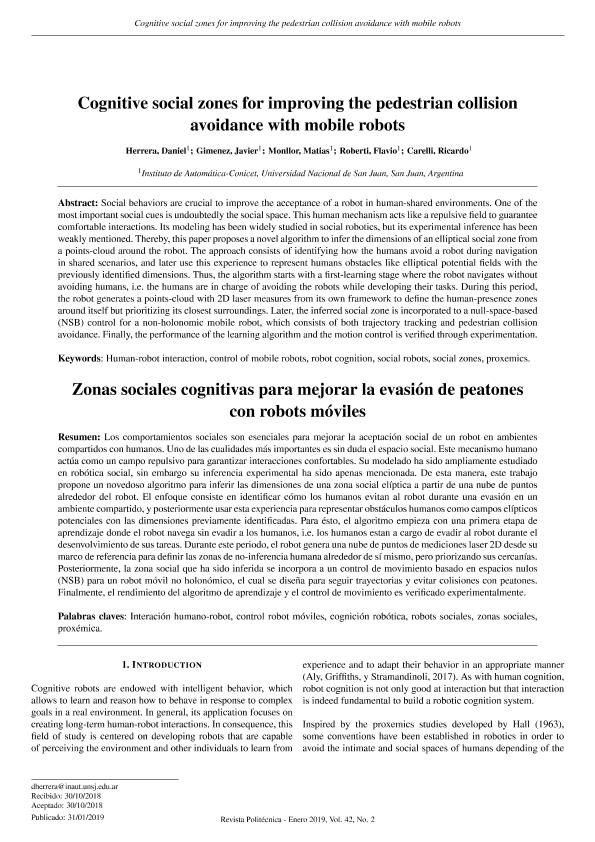Artículo
Los comportamientos sociales son esenciales para mejorar la aceptación social de un robot en ambientes compartidos con humanos. Uno de las cualidades más importantes es sin duda el espacio social. Este mecanismo humano actúa como un campo repulsivo para garantizar interacciones confortables. Su modelado ha sido ampliamente estudiado en robótica social, sin embargo su inferencia experimental ha sido apenas mencionada. De esta manera, este trabajo propone un novedoso algoritmo para inferir las dimensiones de una zona social elíptica a partir de una nube de puntos alrededor del robot. El enfoque consiste en identificar cómo los humanos evitan al robot durante una evasión en un ambiente compartido, y posteriormente usar esta experiencia para representar obstáculos humanos como campos elípticos potenciales con las dimensiones previamente identificadas. Para ésto, el algoritmo empieza con una primera etapa de aprendizaje donde el robot navega sin evadir a los humanos, i.e. los humanos estan a cargo de evadir al robot durante el desenvolvimiento de sus tareas. Durante este periodo, el robot genera una nube de puntos de mediciones laser 2D desde su marco de referencia para definir las zonas de no-inferencia humana alrededor de sí mismo, pero priorizando sus cercanías. Posteriormente, la zona social que ha sido inferida se incorpora a un control de movimiento basado en espacios nulos (NSB) para un robot móvil no holonómico, el cual se diseña para seguir trayectorias y evitar colisiones con peatones. Finalmente, el rendimiento del algoritmo de aprendizaje y el control de movimiento es verificado experimentalmente. Social behaviors are crucial to improve the acceptance of a robot in human-shared environments. One of the most important social cues is undoubtedly the social space. This human mechanism acts like a repulsive field to guarantee comfortable interactions. Its modeling has been widely studied in social robotics, but its experimental inference has been weakly mentioned. Thereby, this paper proposes a novel algorithm to infer the dimensions of an elliptical social zone from a points-cloud around the robot. The approach consists of identifying how the humans avoid a robot during navigation in shared scenarios, and later use this experience to represent humans obstacles like elliptical potential fields with the previously identified dimensions. Thus, the algorithm starts with a first-learning stage where the robot navigates without avoiding humans, i.e. the humans are in charge of avoiding the robots while developing their tasks. During this period, the robot generates a points-cloud with 2D laser measures from its own framework to define the human-presence zones around itself but prioritizing its closest surroundings. Later, the inferred social zone is incorporated to a null-space-based (NSB) control for a non-holonomic mobile robot, which consists of both trajectory tracking and pedestrian collision avoidance. Finally, the performance of the learning algorithm and the motion control is verified through experimentation.
Cognitive social zones for improving the pedestrian collision avoidance with mobile robots
Título:
Zonas sociales cognitivas para mejorar la evasión de peatones con robots móviles
Daniel Herrera; Giménez, Javier; Monllor, Matias Miguel ; Roberti, Flavio
; Roberti, Flavio ; Carelli Albarracin, Ricardo Oscar
; Carelli Albarracin, Ricardo Oscar
 ; Roberti, Flavio
; Roberti, Flavio ; Carelli Albarracin, Ricardo Oscar
; Carelli Albarracin, Ricardo Oscar
Fecha de publicación:
01/2019
Editorial:
Escuela Politécnica Nacional
Revista:
Revista Politécnica
ISSN:
1390-0129
Idioma:
Inglés
Tipo de recurso:
Artículo publicado
Clasificación temática:
Resumen
Archivos asociados
Licencia
Identificadores
Colecciones
Articulos(INAUT)
Articulos de INSTITUTO DE AUTOMATICA
Articulos de INSTITUTO DE AUTOMATICA
Citación
Daniel Herrera; Giménez, Javier; Monllor, Matias Miguel; Roberti, Flavio; Carelli Albarracin, Ricardo Oscar; Cognitive social zones for improving the pedestrian collision avoidance with mobile robots; Escuela Politécnica Nacional; Revista Politécnica; 42; 2; 1-2019; 7-14
Compartir
Altmétricas
Items relacionados
Mostrando titulos relacionados por título, autor y tema.
-
Tashtoush, Tariq; Garcia, Luis; Landa, Gerardo; Amor, Fernando; Laborde, Agustin Nicolas; Oliva, Damian Ernesto ; Safar, Felix Gustavo Emilio (Science and Information Organization, 2021-03)
-
de Cristóforis, Pablo ; Pedre, Sol ; Nitsche, Matias Alejandro ; Fischer, Thomas ; Pessacg, Facundo Hugo ; Di Pietro, Carlos (Institute of Electrical and Electronics Engineers, 2013-02)
-
Montesdeoca, Julio; Toibero, Juan Marcos ; Jordan, Julian; Zell, Andreas; Carelli Albarracin, Ricardo Oscar (Elsevier Science, 2022-03)



